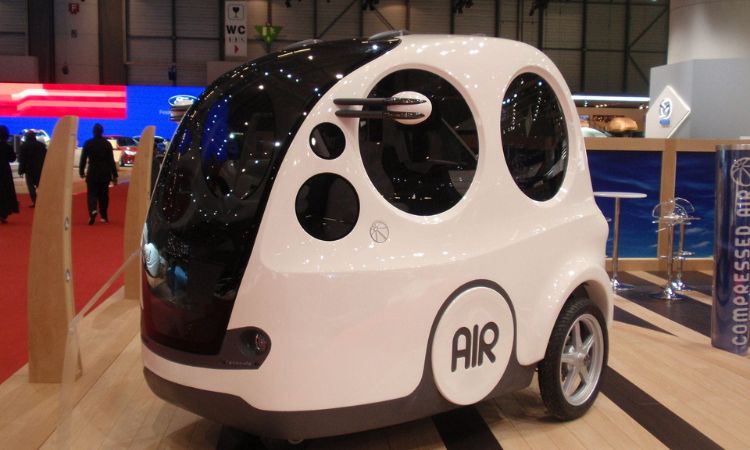The global air-powered vehicle market size stood at a value of USD 517.97 million in 2023. The market is further expected to grow at a CAGR of 24.8% in the forecast period of 2024-2032 to attain a value of USD 3821.72 million by 2032. With these impressive statistics, it’s clear that air-powered vehicles are on the rise and are poised to become a significant player in the transportation industry. In this blog post, we will delve into the world of air-powered vehicles, exploring their technology, advantages, challenges, and their potential to revolutionize sustainable transportation.
Understanding Air-Powered Vehicles
To grasp the significance of air-powered vehicles, it’s essential to understand what they are and how they work. Air-powered vehicles, often referred to as compressed air vehicles (CAVs), are a type of eco-friendly transportation that uses compressed air to propel the vehicle forward. This technology has been in development for several years but is now gaining momentum as environmental concerns and the need for sustainable transportation solutions become more prominent.
A Brief History
The concept of air-powered vehicles is not entirely new. The idea has been around for decades, with various attempts to develop practical air-powered cars dating back to the early 20th century. However, it’s in recent years that significant advancements in technology and materials have made air-powered vehicles more viable.
One of the earliest prototypes of an air-powered vehicle was developed in France in the mid-1800s by engineer Gustave Trouvé. However, it wasn’t until the 21st century that companies and researchers began to seriously explore the potential of air power as a sustainable transportation solution.
How Air-Powered Vehicles Work
Air-powered vehicles operate on a relatively straightforward principle: they use compressed air as a source of energy. Here’s a simplified overview of how they work:
-
Air Compression: The process starts with the compression of ambient air. Specialized compressors are used to store air at high pressure in onboard tanks. The air is compressed to a fraction of its original volume, making it highly pressurized.
-
Energy Release: When the vehicle needs to move, the compressed air is released into the engine. As the air expands, it creates pressure and drives pistons or turbines, which generate mechanical energy.
-
Propulsion: The mechanical energy produced by the expansion of air is used to power the vehicle’s wheels or propulsion system, moving it forward.
-
Regeneration: Air-powered vehicles often have systems in place to recover and reuse some of the energy generated during braking or deceleration, further increasing their efficiency.
The Advantages of Air-Powered Vehicles
Air-powered vehicles offer several notable advantages that make them an attractive option for sustainable transportation:
1. Environmental Benefits
Perhaps the most significant advantage of air-powered vehicles is their minimal environmental impact. They produce zero tailpipe emissions since they use compressed air as their primary fuel source. This is a stark contrast to traditional gasoline or diesel-powered vehicles, which emit harmful pollutants and contribute to air pollution and climate change.
2. Economic Advantages
Air-powered vehicles have the potential to be more cost-effective in the long run. While the initial purchase price of an air-powered vehicle may be comparable to traditional cars, the operational costs are generally lower. Compressed air is cheaper and cleaner than gasoline or diesel fuel, which can result in significant savings over time.
3. Energy Efficiency
Compressed air technology can be highly energy-efficient. When designed and optimized correctly, air-powered vehicles can achieve impressive energy conversion rates, translating into better mileage and reduced energy consumption.
4. Reduced Noise Pollution
Air-powered vehicles are quieter than their internal combustion engine counterparts. This reduction in noise pollution can lead to improved urban environments and less disruption to communities.
5. Lower Maintenance Costs
Compressed air engines are simpler in design than traditional combustion engines. They have fewer moving parts, which means less wear and tear and lower maintenance costs. This can also contribute to longer vehicle lifespans.
6. Increased Energy Independence
By relying on compressed air, countries can reduce their dependence on fossil fuel imports, increasing energy security and reducing vulnerability to oil price fluctuations.
7. Customization Options
Compressed air technology allows for flexibility in design and implementation. Air-powered vehicles can be adapted for various purposes, including cars, buses, bikes, and even industrial applications.
Innovations and Challenges
While air-powered vehicles offer numerous advantages, they also face certain challenges and limitations:
1. Range Limitations
One of the most significant challenges is the limited range of air-powered vehicles compared to traditional gasoline or electric vehicles. Compressed air has lower energy density, which means that vehicles need to carry larger and heavier tanks to achieve longer ranges.
2. Refueling Infrastructure
To become a viable transportation option, air-powered vehicles require a network of refueling stations where drivers can quickly and conveniently refill their compressed air tanks. The development of this infrastructure is a critical challenge.
3. Energy Source
The source of the compressed air also presents challenges. While it can be generated from renewable sources like wind or solar power, many existing systems still rely on electricity generated from fossil fuels, which can offset some of the environmental benefits.
4. Efficiency Improvements
Air-powered vehicle technology is still evolving, and further improvements are needed to enhance energy efficiency, increase range, and optimize performance.
Despite these challenges, ongoing research and development efforts are continuously improving air-powered vehicle technology, making it increasingly practical and viable for a broader range of applications.
Environmental Impact and Sustainability
The environmental impact of air-powered vehicles cannot be overstated. In a world grappling with climate change and pollution, these vehicles offer a promising solution:
Reducing Greenhouse Gas Emissions
Air-powered vehicles produce zero tailpipe emissions. This means they do not release harmful pollutants like carbon dioxide (CO2), nitrogen oxides (NOx), or particulate matter into the atmosphere, helping reduce greenhouse gas emissions that contribute to global warming.
Air Quality Improvement
By eliminating tailpipe emissions, air-powered vehicles contribute to better air quality in urban areas. This can lead to reduced rates of respiratory diseases and overall improvements in public health.
Lower Carbon Footprint
The overall carbon footprint of air-powered vehicles is significantly lower compared to conventional gasoline or diesel vehicles. This makes them a valuable tool in efforts to meet international climate goals and reduce the carbon footprint of transportation.
Market Trends and Adoption
The air-powered vehicle market is experiencing rapid growth, and several factors are driving its adoption:
Government Incentives and Regulations
Many governments around the world are promoting the adoption of eco-friendly transportation solutions. This includes providing incentives such as tax breaks, subsidies, and reduced registration fees for air-powered vehicles. Additionally, stricter emissions regulations are pushing automakers to explore cleaner alternatives.
Urban Mobility Solutions
Air-powered vehicles are particularly suited for urban environments. As cities grapple with traffic congestion and air quality issues, they are increasingly looking to air-powered vehicles as a sustainable mobility solution. Air-powered buses, taxis, and delivery vehicles are becoming common sights in some urban areas.
Investment and Research
Investment in air-powered vehicle technology is on the rise. Startups and established automotive companies are pouring resources into research and development to improve the efficiency and practicality of air-powered vehicles. This investment is expected to accelerate market growth.
Rising Consumer Interest
Consumers are becoming more environmentally conscious and are actively seeking eco-friendly transportation options. As awareness of air-powered vehicles grows, more individuals are considering them as a viable and sustainable choice.
Real-World Examples
To illustrate the impact and potential of air-powered vehicles, let’s take a look at some real-world examples:
1. Tata Motors Air Car
Tata Motors, an Indian automotive manufacturer, developed the Tata Air Car, which runs on compressed air. The car is designed for urban commuting and boasts impressive mileage and zero emissions. It has gained attention for its innovative approach to sustainable transportation.
2. Paris’ Pneumatic Tube Mail System
Paris is home to one of the oldest and most famous uses of compressed air transportation. The city’s pneumatic tube mail system, known as the “Métropolitain pneumatique,” has been in operation since the late 19th century. It uses compressed air to transport mail and parcels across the city through a network of underground tubes.
3. Compressed Air Bicycles
Compressed air bicycles are gaining popularity in urban areas. These bikes use compressed air to assist with pedaling, making them an eco-friendly alternative for commuters who want a little extra help getting up hills or covering longer distances.
These examples showcase the versatility of air-powered technology and its potential for various applications in transportation and logistics.
Challenges and Future Prospects
While air-powered vehicles have made significant strides, several challenges must be addressed to ensure their widespread adoption:
1. Range Anxiety
Range remains a significant concern for air-powered vehicles. The limited distance a vehicle can travel on a single tank of compressed air can be a deterrent for potential buyers. Innovative solutions, such as hybrid systems that combine compressed air with other power sources, are being explored to address this issue.
2. Refueling Infrastructure
The development of a robust refueling infrastructure is essential for the success of air-powered vehicles. Building a network of convenient and accessible refueling stations is a costly and time-consuming endeavor, but it’s crucial for mass adoption.
3. Energy Source
To maximize the sustainability of air-powered vehicles, it’s essential to ensure that the compressed air is generated from renewable energy sources. This would further reduce the carbon footprint of these vehicles and enhance their environmental benefits.
4. Competition with Electric Vehicles
Air-powered vehicles face competition from electric vehicles (EVs), which have already gained significant market share. EVs benefit from a more established infrastructure and longer driving ranges. Air-powered vehicles must offer distinct advantages to compete effectively with EVs.
Despite these challenges, the future prospects for air-powered vehicles are promising. As technology continues to advance and awareness of environmental issues grows, the demand for sustainable transportation solutions is expected to increase.
Conclusion
The global air-powered vehicle market is poised for significant growth, with a projected CAGR of 24.8% between 2024 and 2032, reaching a value of USD 3821.72 million by 2032. This growth reflects the increasing interest in sustainable transportation and the potential of air-powered vehicles to revolutionize the industry.
Air-powered vehicles offer numerous advantages, including environmental benefits, economic advantages, and reduced noise pollution. However, they also face challenges related to range, refueling infrastructure, and energy sources. These challenges are being actively addressed through research, investment, and innovation.
As we move toward a more sustainable future, air-powered vehicles have the potential to play a significant role in reducing greenhouse gas emissions, improving air quality, and offering consumers a cleaner and more cost-effective transportation option. While they may not replace traditional vehicles entirely, they represent a crucial step forward in the quest for greener and more sustainable mobility solutions.





